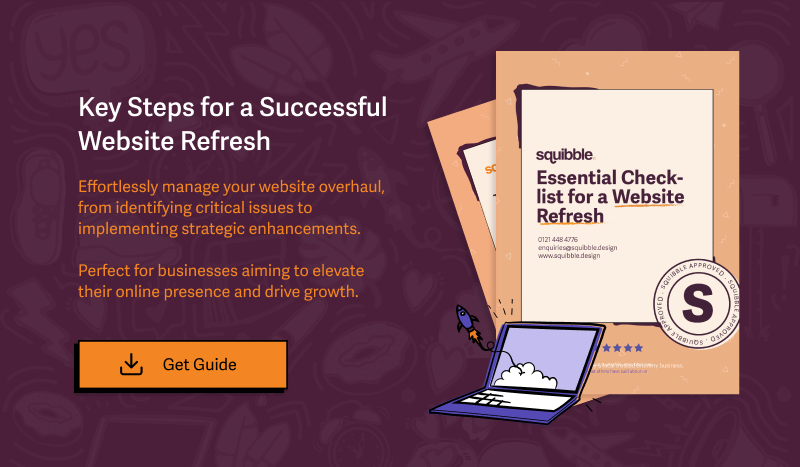How Do I Show ROI on a New Website?
When businesses invest in a new website, they need to see a return on that investment (ROI). ROI measures the profitability of an investment. In the context of websites, it refers to the value that a business gains from the money spent on creating and maintaining the site. This value can come in various forms, such as increased sales, more leads, or enhanced customer engagement.
Demonstrating ROI is crucial, especially for marketing teams and stakeholders who must justify the expenditure. Marketing teams are often responsible for showing how their efforts donate to the company’s bottom line. A new website, a significant investment, must prove its worth. Stakeholders like business owners or investors want to see substantial results from their investments. The website offers measurable benefits as a waste source.
This article will cover the key metrics marketing teams should track to demonstrate the ROI of a new website. By understanding and monitoring these metrics, businesses can see how their website contributes to their goals. Additionally, we will explore how a web design agency can support optimising these metrics, ensuring that the website performs at its best and delivers maximum value.
Critical Metrics for Tracking Website ROI
Measuring ROI involves examining various aspects of a website’s performance. These include traffic metrics like the number of visitors, engagement metrics like how long users stay on the site, and conversion metrics that show how many visitors take desired actions like making a purchase or filling out a form. Technical metrics, including site speed and mobile responsiveness, also play a crucial role in the site’s overall performance.
- Traffic Metrics: Track the number of visitors, page views, and sessions to understand how many people are coming to the site and how they engage with the content.
- Engagement Metrics: Monitor bounce rates, average session duration, and pages per session to track how effectively the site retains visitors and encourages deeper interaction.
- Conversion Metrics: Measure the conversion rate, cost per conversion, and the effectiveness of calls to action to see how well the site turns visitors into customers or leads.
- Technical Metrics: Ensure the site loads quickly and is mobile-friendly. Slow load times and poor mobile performance can drive users away and negatively impact other metrics.
How a Web Design Agency Can Help
A web design agency can be instrumental in achieving a high ROI. They bring expertise in optimising site performance, enhancing user experience, and implementing practical tracking tools. For instance, improving site speed can reduce bounce rates and increase user satisfaction, leading to higher conversions. Simplifying the website menu bar and making it more user-friendly can also enhance engagement and encourage visitors to take action.
Moreover, a design agency can set up comprehensive analytics to monitor and analyse these metrics. They can create custom dashboards that provide real-time data, making it easier for marketing teams to track progress and make informed decisions. By continuously analysing and refining the website based on data, a web design agency ensures that the site evolves to meet changing user needs and business goals.
Understanding ROI in Web Design
What Does ROI Mean for a Website?
ROI, or Return on Investment, measures the profitability of an investment. When discussing ROI for a website, we look at the value a business gains from the money spent on designing, developing, and maintaining the site. This value can come in various forms, such as increased sales, more leads, improved customer engagement, or enhanced brand awareness. It’s about understanding whether the website delivers enough benefits to justify its cost.
Why Measuring ROI is Critical for B2B Businesses
For B2B companies, measuring the ROI of a website is crucial. Unlike B2C businesses, B2B sales cycles are often longer and more complex, involving multiple stakeholders and higher-value transactions. Therefore, a well-designed website can be a powerful tool to attract and nurture potential clients through this journey.
- Justifying Investment: Stakeholders and decision-makers must see clear evidence that the website is worth the investment. A site needs to deliver measurable benefits to justify the ongoing costs of maintenance and updates.
- Optimising Marketing Strategies: By understanding which aspects of the website are performing well and which are not, businesses can refine their marketing strategies. This ensures that time can be allocated effectively, focusing on areas that drive the most value.
- Competitive Advantage: In the B2B space, having a website clearly demonstrates its value can set a company apart. A high-performing site can enhance credibility and make a strong impression on potential clients.
Common Goals for B2B Websites
There are several common goals that B2B websites aim to achieve, each contributing to overall ROI:
- Lead Generation: One of the main goals for many B2B websites is to generate leads. This can involve capturing visitor information through forms, offering valuable content downloads, or encouraging sign-ups for newsletters and webinars. Effective lead-generation strategies help convert anonymous website visitors into potential customers.
- Customer Engagement: Engaging with potential and existing customers is vital. A website that offers valuable content, interactive elements, and a seamless user experience can keep visitors on the site longer and encourage them to return. High engagement levels can lead to stronger relationships and increased loyalty.
- Sales Conversion: Ultimately, the goal of many B2B websites is to convert leads into sales. This can involve providing detailed product information, showcasing case studies, and offering easy ways for potential clients to get in touch or request a demo. The smoother and more persuasive the sales journey, the higher the conversion rate.
By focusing on these goals, B2B businesses can ensure their website is not just an online brochure but a dynamic tool that actively contributes to their success. Measuring the ROI of these activities helps companies understand their website’s true impact and make informed decisions about future investments.

Critical Metrics for Tracking Website ROI
To effectively measure the ROI of a website, it’s essential to track various key metrics. These metrics provide valuable insights into how well the site is performing and where improvements can be made. Here are the main categories of metrics to consider:
Traffic Metrics
Page Views, Unique Visitors, and Sessions
These metrics help you understand the overall volume of traffic to your website.
- Page Views: The total number of times pages on your site have been viewed.
- Unique Visitors: The number of people visiting your site during a specific period. This avoids counting the same visitor multiple times.
- Sessions: The number of visits to your site, where one session can include multiple page views.
Traffic Sources
Knowing where your traffic comes from is essential for assessing the effectiveness of your marketing efforts.
- Organic Traffic: Users who find your site through search engines.
- Direct Traffic: Visitors who type your website URL directly into their browser.
- Referral Traffic: Visitors who come to your site from other websites.
- Paid Traffic: Visitors who come through paid advertisements.
Engagement Metrics
Bounce Rate, Average Session Duration, and Pages per Session
These metrics give you an idea of how engaged visitors are with your site.
- Bounce Rate: The percentage of visitors who leave your site after viewing only one page. A high bounce rate may indicate that the site needs to meet visitors’ expectations.
- Average Session Duration: The average time visitors spend on your site. Longer durations suggest higher engagement.
- Pages per Session: The average number of pages a visitor views during a session. More pages per session indicate visitors find your content engaging and worth exploring.
User Behavior Flow
This metric shows visitors’ path through your site, highlighting which pages they visit first, where they go next, and where they drop off. Understanding user behavior flow helps identify popular content and potential bottlenecks in the user journey.
Conversion Metrics
Conversion Rate
The percentage of visitors who complete a desired action, such as filling out a form, downloading a resource, or making a purchase. A higher conversion rate indicates that the site effectively encourages visitors to take these actions.
Cost per Conversion
The amount of money spent on marketing efforts to achieve one conversion. Lowering the cost per conversion means you’re getting more value from your marketing budget.
Customer Journey Metrics
Time to Convert
The average time it takes for a visitor to complete a conversion from their first visit. Shorter times to convert indicate a more efficient and persuasive user journey.
User Flow Analysis
This involves tracking how visitors move through your site from entry to conversion. It helps identify which paths lead to successful conversions and which need improvement.
Technical Metrics
Site Speed and Load Times
The time it takes for your website to load fully. Faster load times improve user experience and can reduce bounce rates, especially on mobile devices.
Mobile Responsiveness
How well does your site perform on mobile devices? With an increasing number of users accessing websites via smartphones and tablets, ensuring a smooth mobile experience is essential.
SEO Performance
- Ranking: How your site ranks on search engine results pages (SERPs) for relevant keywords. Higher rankings typically lead to more organic traffic.
- Organic Search Traffic: The number of visitors who come to your site via search engines. This metric reflects the effectiveness of your SEO efforts.

How a Web Design Agency Can Help
A web design agency plays a crucial role in enhancing the effectiveness of a website, ensuring it delivers a high return on investment (ROI). By optimising site performance, enhancing user experience, and implementing robust analytics and tracking systems, a web design agency can significantly improve your site’s overall performance. Here’s how:
Optimising Site Performance
Techniques for Improving Site Speed and Load Times
Site speed is critical in user satisfaction and search engine ranking. A slow-loading website can frustrate users, leading to higher bounce rates and lower engagement. Here are some techniques a web design agency can use to improve site speed:
- Minimising HTTP Requests: Reducing the number of elements on a page (such as images, scripts, and CSS files) can decrease load times. Combining files and using CSS sprites can help.
- Optimising Images: Large image files can slow down a site. A web design agency can compress images without sacrificing quality, ensuring faster load times.
- Leveraging Browser Caching: By enabling caching, parts of the website are stored in the user’s browser, reducing load times for repeat visitors.
- Reducing Server Response Time: Using faster hosting services, optimising databases, and employing content delivery networks (CDNs) can significantly speed up server response times.
- Minifying CSS, JavaScript, and HTML: Removing unnecessary characters, spaces, and comments from code files can make them lighter and faster to load.
Ensuring Mobile Responsiveness and Cross-Device Compatibility
With most website visitors using their mobile devices to browse, ensuring your website is mobile-friendly is essential. A responsive design adapts to different screen sizes and devices, providing a seamless experience for all users. A web design agency can ensure the following:
- Responsive Design: By using flexible grids and layouts, images, and CSS media queries, the site will adjust smoothly to various screen sizes.
- Touch-Friendly Elements: Ensuring buttons and navigation elements are easily clickable on touchscreens.
- Optimised Media Queries: Using media queries to apply different styles for different devices, ensuring the website looks good on all screen sizes.
- Testing Across Devices: Regular testing on various devices and browsers to ensure compatibility and a consistent user experience.
Enhancing User Experience
Reducing Friction in the Customer Journey
Friction in the customer journey can deter users from completing desired actions. A web design agency can identify and reduce these friction points to enhance the user experience:
- Streamlined Forms: Simplifying forms by reducing the number of fields and making them easy to complete.
- Clear Calls to Action (CTAs): Designing prominent and compelling CTAs that guide users towards desired actions.
- Intuitive Navigation: Creating a logical and easy-to-use navigation structure that helps users find information quickly and easily.
- Fast Load Times: As mentioned earlier, a fast-loading site keeps users engaged and reduces the likelihood of them abandoning the site.
Simplifying Navigation and Improving Usability
A user-friendly website keeps visitors engaged and encourages them to explore more. A web design agency can enhance usability by:
- Logical Menu Structure: Organising menus in a way that makes sense to users, with clear labels and a logical hierarchy.
- Consistent Layouts: Maintaining a consistent layout across all pages to provide a predictable and intuitive experience.
- Accessible Design: Ensuring the site is accessible to all users, including those with disabilities, by following web accessibility guidelines.
- Interactive Elements: Incorporating interactive elements like dropdowns, hover effects, and animations to enhance user engagement without overwhelming them.


Implementing Analytics and Tracking
Setting Up Tools like Google Analytics and Heatmaps
Effective tracking and analytics are essential for understanding user behaviour and measuring ROI. A web design agency can set up and configure these tools to provide comprehensive insights:
- Google Analytics: Set up Google Analytics to track key metrics such as traffic sources, user behavior, conversion rates, and more. This data helps understand how users interact with the site and identify areas for improvement.
- Heatmaps: Implementing heatmap tools to visually represent where users click, scroll, and spend the most time on the site. Heatmaps provide valuable insights into user behaviour and highlight which areas of the site are most engaging.
Custom Dashboard Creation for Real-Time Monitoring
To make data more accessible and actionable, a web design agency can create custom dashboards:
- Real-Time Monitoring: Custom dashboards provide real-time data on site performance, allowing for quick identification and resolution of issues.
- Key Metrics at a Glance: Dashboards can display key metrics such as traffic, engagement, and conversions in an easy-to-understand format.
- Actionable Insights: Dashboards enable marketing teams to make informed decisions and adjust their strategies by highlighting critical data points and trends.
- Integration with Other Tools: Custom dashboards can integrate data from various sources, such as social media, email marketing, and CRM systems, providing a comprehensive view of performance.
In summary, a web design agency can significantly enhance a website’s ROI through optimising site performance, improving user experience, and implementing robust analytics and tracking systems. By focusing on these areas, businesses can ensure their websites are attractive, user-friendly, and effective tools for driving growth and achieving business goals.


Best Practices for Marketing Teams
Collaboration with Design Agencies
Importance of Clear Communication and Setting Expectations
Effective collaboration between marketing teams and web design agencies begins with clear communication and well-defined expectations.
- Clear Communication: Open and transparent communication helps ensure that both parties understand the goals, timelines, and deliverables. Regular updates and clear briefings help prevent misunderstandings and keep the project on track.
- Setting Expectations: Establishing clear expectations regarding the scope of work, deadlines, and budget is crucial. Both the marketing team and the design agency should agree on the project objectives, the key performance indicators (KPIs) to be tracked, and the roles and responsibilities of each team member. This helps avoid scope creep and ensures everyone works towards the same goals.
Regular Check-ins and Feedback Loops
Maintaining regular check-ins and feedback loops is essential for the success of a project.
- Regular Check-ins: Scheduled meetings, whether weekly or bi-weekly, keep everyone aligned and provide opportunities to promptly address any issues or changes. These check-ins help ensure that the project is progressing as planned and allow for adjustments to be made if necessary.
- Feedback Loops: Constructive feedback is vital for continuous improvement. Encouraging open and honest feedback from both the marketing team and the design agency helps identify areas for improvement. It ensures that the final product meets expectations. Implementing feedback loops where changes and updates are reviewed and refined continuously ensures that the website evolves in the right direction.
Continuous Improvement
Importance of Ongoing Analysis and Updates
Websites should never remain static. Continuous analysis and updates are essential for maintaining a high-performing website that meets user needs and business goals.
- Ongoing Analysis: Regularly analysing website performance using analytics tools helps identify trends, user behaviour, and potential issues. By understanding how users interact with the site, marketing teams can make data-driven decisions to enhance user experience and improve conversion rates.
- Updates: The digital landscape is constantly changing, and websites need to evolve to stay relevant. This includes updating content, design elements, and technical features. Regular updates ensure that the website remains fresh, engaging, and optimised for performance.
Using A/B Testing to Optimise Elements of the Website
A/B testing is a powerful method for optimising various elements of a website.
- A/B Testing: This involves comparing two versions of a web page or element to see which performs better. For example, testing different headlines, images, or call-to-action buttons can provide insights into what resonates most with users. By systematically testing and iterating, marketing teams can make informed decisions that enhance user experience and increase conversions.
- Continuous Optimisation: A/B testing should be an ongoing process. Continuously testing and refining different website elements helps optimise them and ensure they perform at their best. This approach allows marketing teams to adapt to changing user preferences and market conditions.
Leveraging Data
Making Data-Driven Decisions Based on Tracked Metrics
Data is a valuable asset that can guide decision-making and strategy development.
- Data-Driven Decisions: By leveraging data collected from analytics tools, heatmaps, and user feedback, marketing teams can make informed decisions that enhance website performance. Data-driven decisions help prioritise changes that will have the most significant impact on user experience and business outcomes.
- Identifying Opportunities: Data can reveal opportunities for improvement and innovation. For example, identifying high-performing content or popular user paths can inform content strategy and site navigation improvements.
Aligning Website Goals with Broader Marketing Strategies
The website should align with the broader marketing and business strategies to ensure coherence and maximise impact.
- Strategic Alignment: The website’s goals and objectives should support the overall marketing strategy. This includes ensuring the website reflects the brand’s messaging, values, and goals. For example, suppose a key marketing objective is to increase lead generation. In that case, the website should have effective lead capture forms and clear calls to action.
- Integrated Approach: An integrated approach ensures that all marketing channels work together seamlessly. For instance, the website should complement social media campaigns, email marketing, and other marketing efforts. This alignment helps create a cohesive user journey and maximises the effectiveness of marketing initiatives.
Effective collaboration with design agencies, continuous improvement through analysis and A/B testing, and leveraging data for informed decision-making are essential practices for marketing teams. By aligning website goals with broader marketing strategies, teams can ensure their websites look good and drive meaningful business results.










